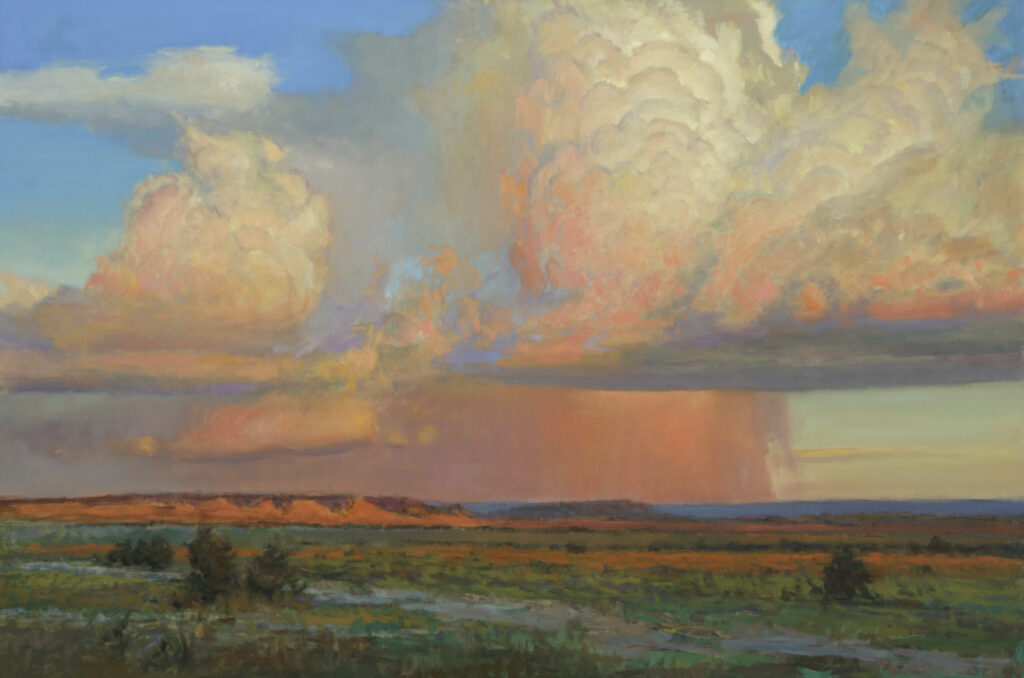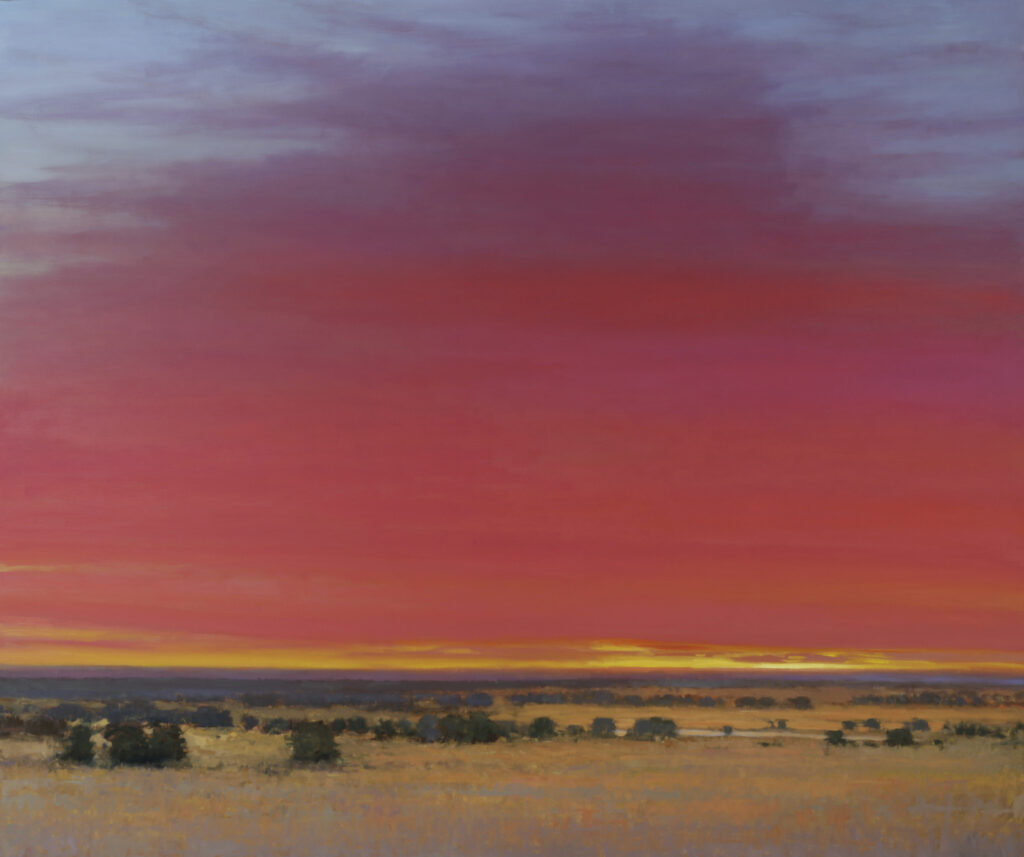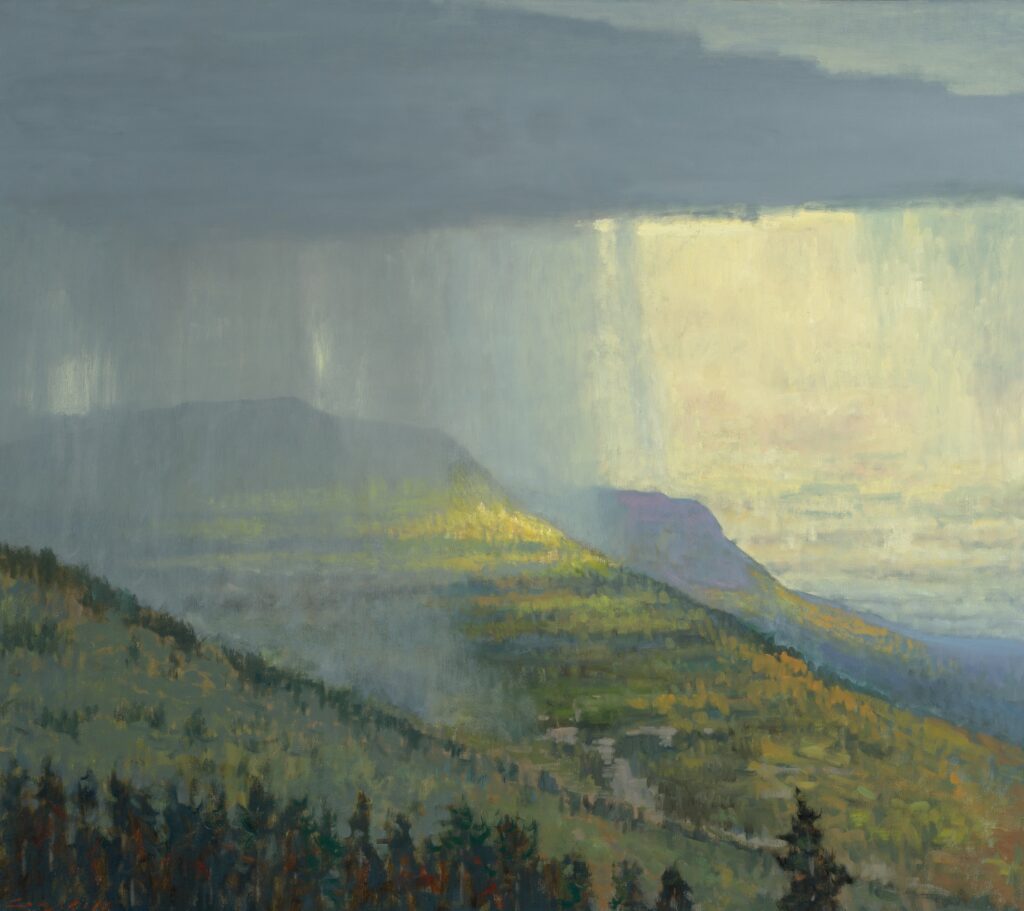Durango, Colorado painter Peter Campbell seeks in the landscape what he sees in his mind’s eye. His process begins with a vision that he then finds in the landscape of Colorado or New Mexico where he makes a sketch of the landscape, notes of color, a charcoal sketch on canvas that gets wiped away. With a clear vision in mind, he paints, mixing the colors of each brush stroke, layering color and texture to depict the big-sky landscapes that drew him west. Read an interview between Ann Korologos Gallery and Peter Campbell. Note: the interview has been lightly edited for clarity and length.
Peter Campbell: If I go driving around looking for paintings, I have a painting in mind: A mood, a set of trees, the way the horizon goes, if it’s going to be more sky, less sky. I know it’s nuts, but I actually have a thing that I’m looking for, and I drive around until I see it, and when I find it, I know, “That’s it. That’s what I was looking for.” If I don’t see it, I go home and I don’t paint that.
Peter Campbell: I’m to the point now where I just carry a small sketchbook, and I’ll do thumbnail sketches and I might write down a color reference or something like that. I’ll take a picture, or if I have time I’ll do plein air work. But I don’t do as much plein air as I used to. For the most part, if I get it down in pencil first, I’m okay, because if you see it and it is “the thing,” and you’ve recognized it, then now it’s in my head. So, that’s the easiest painting to make – the one that’s already in your head.
Peter Campbell: Lately, I’ve been starting with a soft vine charcoal. It is not permanent – it’s just dust on paper. I can draw really quickly what’s going on in my canvas. I can put in a whole mass of dark and then wipe it back with a rag, and I can work out what I want to have happen. I’ve got light and dark. I got my values and my shapes, and I’m working on creating that painting without actually having to put anything on the canvas. And then once I’ve gotten there, I take a rag and wipe it off. Then I start the painting. It gives me an extra way of working that is sort of like what [James McNeill Whistler] did. He would paint for the day, and then at the end of the day, he would scrape off everything that he had painted and leave a ghost of what was there, because he felt like the final skin of the painting should be one cohesive element. As an image maker, getting it in your mind is the thing. Once you get it in your mind, then the rest of it is easy, but you have got to have some sort of vision.
Peter Campbell: I have a visual memory, yeah. I learned visually. I learned how to ski by having my brother ski in front of me. I don’t go anywhere and do anything that I’m not painting in my mind. I’m constantly painting. I saw a dozen paintings on the way over here.

Peter Campbell: I had some help from just being a photographer for so many years and being able to predict what light does, being able to invent it, or recognize it and make a note of it.
In college I started doing historical techniques, things like cyanotypes, calotypes, gum Arabic printing and palladium printing. In these processes, you’re controlling what the color does or you’re controlling the tonality – you really start getting your hands in the process. And so, for me photographically, I like that. And I started doing things where I was doing hand coloring and I was doing etching into the pictures. And then slowly but surely, I was like, “Okay, well now I don’t need reality anymore. I don’t need my camera. I’d rather started from scratch and just have it be my hands from start to finish.” And so that was the initial draw for me towards painting because I didn’t need to actually shoot something. I didn’t have to wait for the sun to do this. I didn’t have to be there. I could take what was happening and make it my own and create my own landscapes. I do love the creative license. We’re artists, you know.

Peter Campbell: Yes, absolutely. They say, “Color takes the credit, value does the work.” And that’s kind of the case. I think it’s taken me longer to have a good sense of color because I’ve thought as a black and white photographer. So, I tended to mute my colors a lot more than I do now. Gradually I’ve let go of that and just been a little more conscious of my color.
Peter Campbell: For me, mixing colors is fun – that and mixing value. I may not be good at everything, but one thing I’m good at is if you have a value and a color in front of me, it won’t take me more than about two or three mixes to get it exactly right.
A lot of painters don’t play with it enough. I’ll start mixing color just to see if I can surprise myself with what kind of color I’m going to end up with. There are surprising mixes that you only find out by mixing color. For example, if you take a cold green like Viridian and a cold red like Alizarin Crimson and you mix them together, what color do you think you’re going to get? Well, you actually get this beautiful violet. If you looked at some of John Singer Sargent’s work, some of his skin tones actually have that kind of neutral violet that you just wouldn’t expect.
Peter Campbell: My palette is small – about 16 by 20 inches – because I mix each brushstroke individually. I can remix color. I have a great color memory. For some reason, that part is not hard. So, if I’m painting a big sky, I’ve mixed up every inch. I don’t mix a big pool of color and go over the whole sky. I do it inch by inch, piece by piece. I like just remixing and remixing.
Peter Campbell: I used to think I had to hold on to that idea through the whole painting. And that’s the way I used to work – religiously – I would not deviate. I would not let the painting interfere. And now I’m kind of the opposite. I’m much more free. I’m willing to see where it goes. And if I feel like changing it, I change it, and let it go that way. And I believe I’m more successful doing that than I was trying to pre-plan.
Peter Campbell: I tell people paintings go several ways. One is like pushing a stone up a hill and it just keeps rolling back down, you know, like Sisyphus. And other times it’s like letting go of a helium balloon. It’s that easy. I feel like I was just the medium, you know, I was just the thing that made the idea become a painting. And then if somebody buys it, they become a caretaker. And hopefully it’ll make it down the road.
Peter Campbell: No, it has just been gradual. Just, what’s important. Age. You get older, you start deciding what’s important.
Peter Campbell: I don’t go with happiness. Happiness is a ruse. Satisfaction – that’s really probably the key. Are you satisfied with your labor or are you satisfied with what you do? Because status is going to go – that doesn’t I mean anything – nothing means anything except are you happy today or are you doing what you want to do? I never thought I’d be able to do what I’m doing. Never considered it and didn’t grow up going, “I want to be a painter.” I mean, I loved painting and I remember even the first time I went to a museum, I saw Andrew Wyeth’s work when I was a kid and I saw a Jackson Pollock when I was a kid. And I was just enthralled.
Peter Campbell: We — the painting and I – have a history and it’s not always a good relationship. A lot of times it is, but not always. For the viewer, what you guys see of the painting is completely different than what I see because I had to build it from the ground up. I see all the mistakes, all the things or the changes. I heard another painter say, “It’s the painter’s curse.” You can’t appreciate your work like that. That’s why I love other painters works. You know, you go up to it, it’s like, “Man, that’s amazing.” And I try not to think of what they had to go through to get it to be that way.

Peter Campbell: I mean that’s the other thing – the only way you’re assured that work is going to be here in the future is if somebody buys it, takes care of it and passes it along. You know, I bet you there are tons of painters in the Renaissance that we don’t know anything about because people didn’t purchase their work or didn’t take care of them.